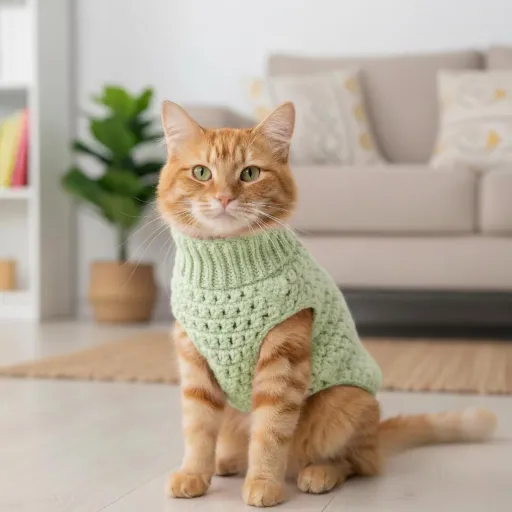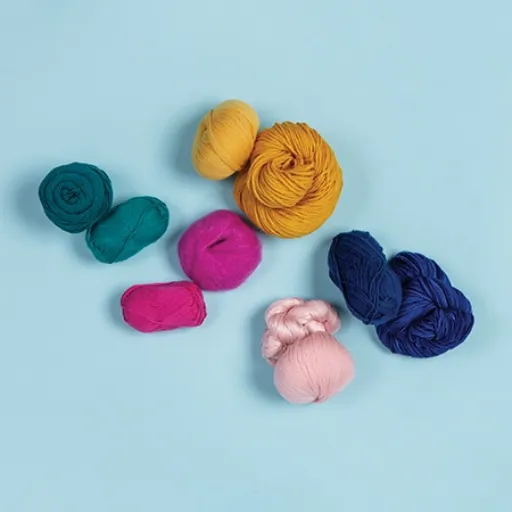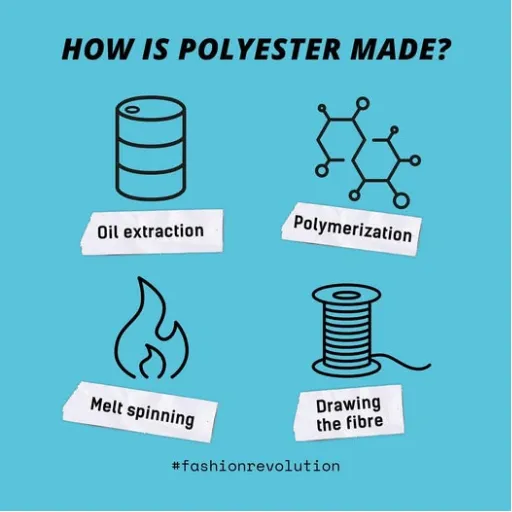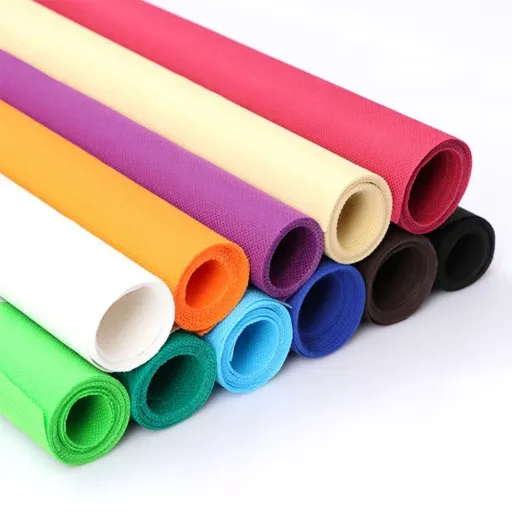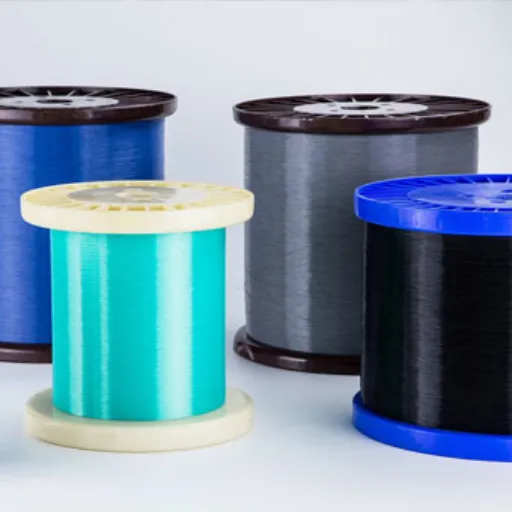Polyester fabric is probably the most versatile fabric and one of the most used fabrics in the textile world, but have you ever wondered why it is so famous? From durability to cheapness, polyester is a fabric that goes into clothes, furnishings, or even uncombed industrial use. This blog deeply goes into the polyester world to bring its origins and fiber-making process to light. Along the way, you will understand how this synthesis made a revolution upon our understanding of fabric and how the industry still uses that insight-it is a thought to ponder. Curious about the polymer and its impact on sustainable fashion? Then you’ll get all those answers and more in this guide into the very special life of polyester.
Understanding Polyester Fabric
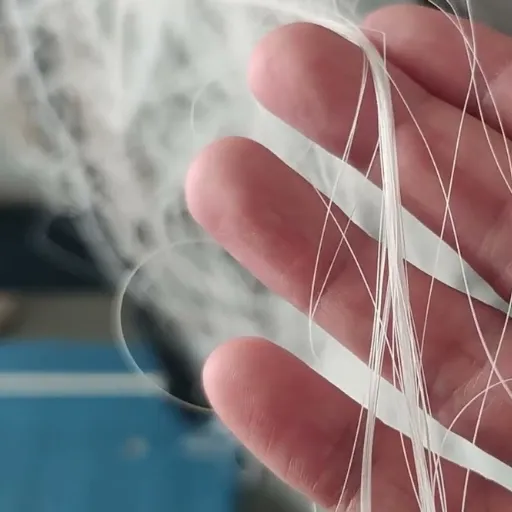
Definition and Composition of Polyester
Polyester is a synthetic fiber made mainly from petroleum-based products. It consists of long polymer chains, with polyethylene terephthalate (PET) being the polymer most often produced via a chemical reaction between purified terephthalic acid (PTA) and monoethylene glycol (MEG). This polymer forms very strong and durable fibers that can be woven or knitted into many different types of fabric.
One hallmark of polyester is its versatility. The fibers resist shrinking, stretching, and wrinkling, suitable for a much wider range of uses-from garments to household items, to industrial applications. Other useful characteristics are that polyester fabrics can repel moisture and are quick-drying, which is especially desirable in sports and outdoor wear.
Given their relatively low price and functionality, polyesters rapidly gained favor with consumers, resulting in growing environmental concerns about disposal and environmental effects of production. The fiber does not degrade naturally and is processed primarily through fossil fuels that make the carbonaceous path for a considerable footprint on the environment. On the brighter side, new recycling technologies have led to the invention of recycled polyester that uses plastic waste as raw material to produce new fibers, thus opening-doors for sustainable means in textiles.
Properties of Polyester Fabric
Polyester fabric is a synthetic material well-known for its strength and vast range of uses. Its strength is one of its chief attributes: particles cannot easily tear or stretch. Thus, with damages prevented, the fabric can hold its shape for prolonged use. Also, polyester fabric resists strong washing, another hallmark of durability.
It resists wrinkles and shrinkage to some extent, so the smooth untarnished look of polyester fabric over time means fewer chances to iron clothes and make it a perfect choice for easy-care clothing and home textile. Polyester is also considered to be resistant to tough outside factors such as moisture, the rays of the sun, and that of the mildew, lofting it up for outdoor apparel, and furniture.
Furthemore, the moisture-wicking ability of polyester adds to its usefulness: It will repel water to some extent while allowing perspiration to escape, thus keeping the wearer cool during physical activity. With such features, polyester sportswear, upholstery, and many other materials are ranked at the top of the list, thus receiving versatility for different applications.
Types of Polyester Fabric
There are different types of polyester fabric, all suited to varying applications. The most common types are PET (polyethylene terephthalate), PCDT (poly-1,4-cyclohexylene-dimethylene terephthalate), microfiber, and recycled polyester. These variations differ by properties, texture, and functionality, providing a versatile polyester for various industries.
PET Polyester
PET is the most popular polyester fabric. This polyester type is durable, light in weight, and easy to maintain, while its main uses are in apparel, home furnishings, and industrial textiles. Given that PET can also be recycled, it gains extra points on the sustainability score.
PCDT Polyester
PCDT is more elastic and durable than PET. Because of this, this polyester is very much sought for applications requiring added strength and flexibility, such as heavy-duty curtains, upholstery, and industrial fabrics.
Microfiber Polyester
Microfiber polyester has extremely fine fibers that give it a soft smooth texture. It is applied in cleaning cloths, bedding, and clothing. Besides, it can trap dust and moisture, making it suitable for fine cleaning.
Recycled Polyester
Recycled polyester, commonly made from used plastic bottles or other PET-based items, is the green alternative to conventional polyester. It reduces waste and energy consumption during production, pouring into the worthy application list of the concerned manufacturers and consumers.
So, as each type of polyester boasts unique features, it can service different demands in apparel, furniture, and beyond. The versatility and adaptability of polyester make it one of the most dominant materials in today’s textiles.
The Polyester Production Process
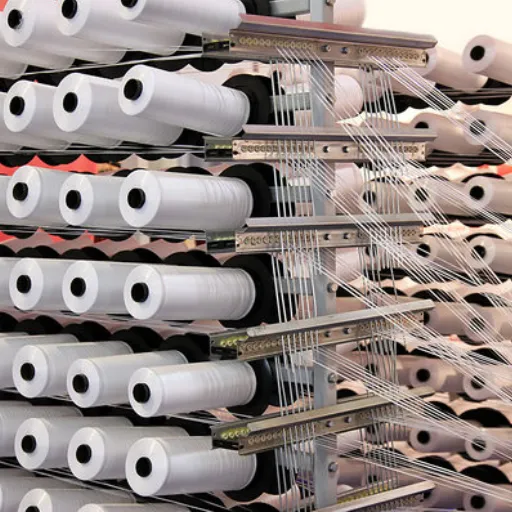
Raw Materials for Polyester Production
Polyester production primarily relies on petroleum-based raw materials. The two key ingredients are purified terephthalic acid (PTA) or maybe dimethyl terephthalate (DMT) and monoethylene glycol (MEG). These chemicals are derived from crude oil and natural gas through several chemical processes, making them the building blocks for the synthesis of polyester.
Starting with polymerization of terephthalic acid or dimethyl terephthalate with ethylene glycol under controlled temperature and pressure, polyester formation results in long polymer chains which may then be spun into fibers or molded into varied forms according to the intended application. Additives and dyes can also be introduced during this process for the accentuation of certain properties or to carry out coloring.
Since these raw materials mostly come from non-renewable resources, environmentalists raised their concerns pushing the polyester industry to look for alternatives. Bio-MEG from renewable plant sources is one of the alternatives. Another solution to meet industry requirements would be to recycle the existing polyester into new fibers instead of developing products from virgin resources.
Polyester Fiber Manufacturing Steps
Manufacturing polyester fibers is a multi-stage process that begins with the polyester polymers’ synthesis. Polycondensation polymerization takes place on the primary raw materials that include ethylene glycol and terephthalic acid. This step causes molecules to bond together, forming long chains of polyethylene terephthalate (PET) that serves as the base for polyester. The polymer is then cooled into chips or pellets for the subsequent processes.
These chips are melted and extruded through spinnerets to give out fine strands of continuous filament fibers. At this stage, modifications can be made to change the fiber thickness or texture, both of which determine the product characteristics. The filaments are vitrified by cooling and then drawn to further align the polymers molecules, enhance their strength, and increase elasticity.
Now the fibers are made to meet the requirements of the actual application. They could be texturized to produce softness, dyed in color, or mixed with other materials to impart specific qualities to the fabric. Some are recycled into new polyester fibers through either mechanical or chemical means, which then go toward sustainable manufacturing. This simplified complicated process has allowed polyester to maintain its versatility and be used in so many areas of industry.
Polymerization and Chemical Reactions
Polyester forms in a process known as polymerization, wherein monomers such as ethylene glycol and terephthalic acid are chemically reacted into long polymer chains. This reaction, often during the catalytic action of a chemical compound under controlled heat and pressure, creates polyethylene terephthalate or PET, the foremost and widely used polyester. These polymer substances are then processed by cooling and chopping into tiny pellets or chips, which act as feedstocks for further processing.
When the polyester chips are delivered from polymerization, they are heated and melted into the liquid state, extruded through spinnerets with numerous very tiny holes for the creation of long continuous filaments. The filaments are instantly cooled and solidified to make fibers. These fibers are either left as continuous filament impregnations or converted into staples, based on the time or application. The length of staples is chosen carefully.
In treatments to improve the properties of finished polyester fiber are drawing of fibers to strengthen, apply coatings for durability, and texturizing for softness or other textures. After having been optimized, the fibers are used for textiles, industrial use, or packaging. Such a manufacturing technique for Polyester thus allows great versatility and ranks it as one of the largest-geared synthetic materials used all over the globe.
Types of Polyester
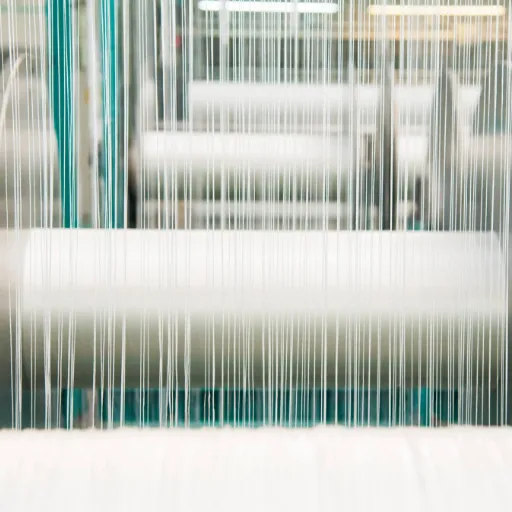
Common Types: PET and PCDT
Polyethylene Terephthalate (PET) holds the rank of the most popular polyester primarily based on superior strength, durability, and versatility. PET fibers are mainly used in garments, furnishings, and several industrial applications. It is actually one of the few polyesters which neither stretches in use nor shrinks in the wash; hence, it is popularly employed to make wrinkle-resistant fabric. This is also one of the factors why PET stands up well against most chemicals and environmental conditions which has made packaging its major field of application in the form of plastic bottles.
Poly-1,4-Cyclohexylene-Dimethylene Terephthalate (PCDT) is another important type of polyester, exhibiting more elasticity and resilience than PET. Though it may not be as common as PET, PCDT is preferred in applications demanding high elasticity or durability. Examples of such fabrics would be for rugs, curtains, and heavy-duty textiles where PCDT fibers help maintain strength and flexibility during prolonged periods of use. Hence, PCDT is suitable for applications that require both elasticity and consistent performance under stress.
Both PET and PCDT play important roles in the textile and industrial fields, each having its own merits. On occasion, PCDT meets the needs that require more elasticity, whereas on the other hand, PET is more versatile and strong for a wider array of uses. Together, they show just how versatile polyester can be in general, indicating the prime place it holds in recent manufacturing and also in everyday products.
Differences in Properties and Uses
| Property | PET Polyester | PCDT Polyester |
|---|---|---|
| Strength & Rigidity | High strength and rigidity with excellent chemical resistance | More flexible and elastic than PET |
| Temperature Tolerance | Higher melting point, stable at elevated temperatures | Lower heat tolerance than PET |
| Common Applications | Beverage bottles, food containers, textile fibers | Upholstery, seat belts, industrial fabrics, curtains |
| Best For | Durability and stability requirements | Flexibility under repeated stress or cyclic loading |
The difference in their properties sets these two polymers apart with respect to their separate end-use applications. PET is known for its high strength and rigidity, with a good resistance to chemicals. This finds it in applications where durability and stability are essential: beverage bottles, food containers, and textile fibers. PCDT is more flexible and elastic than PET and hence better suited for stretchable applications such as upholstery or certain types of apparel.
In terms of temperature tolerance, PET has the edge over PCDT because of the former’s higher melting point and stability at elevated temperatures, an attribute cherished by the packaging industry where it is favored as an alternative to glass or metal. PCDT lends itself to applications where flexibility under repeated stress or cyclic loading is needed, thus making it superior for the manufacture of seat belts or industrial fabrics where continuous motion or strain is involved.
These subtle differences make the two polyesters unique in their strengths. With PET being versatile with strength, the material is widely used for consumer and industrial products, while with its elasticity and strength, PCDT fills niche applications where similar flexibility is demanded. With these features, the two polyesters show just how adaptable polyester is in serving diverse industrial needs.
Polyester Yarn and Thread Production
Polyester yarn and thread production begins with the polymerization of raw materials such as purified terephthalic acid (PTA) and monoethylene glycol (MEG). These substances chemically react to form polyethylene terephthalate (PET), the base polymer for polyester. The product is then melted and extruded into fine strands to form the polyester filaments for yarn and thread.
After extrusion, the fibers are cooled and stretched until the desired thickness and strength are attained. The drawing process aligns the molecular structure of the polyester and improves its durability and tensile strength. The fibers may be held as continuous filaments or cut into shorter lengths called staple fibers, which are spun into yarn, depending on the application. Continuous filament yarns are generally used for fabrics requiring smoothness and strength, while staple fiber yarns are used to produce softer, textured fabrics.
Lastly, the yarns are subjected to finishing treatments for special purposes. These treatments may involve dyeing, heat-setting, or coating to impart certain properties to the yarns, such as colorfastness, elasticity, or resistance to moisture. Polyester yarn and thread are commonly used in the manufacture of textiles for apparel, domestic uses, automotives, and industrial applications, mainly for their suitability, cheapness, and performance characteristics. Given such production flexibility, the manufacturers can make polyester materials according to widely varying needs.
Applications of Polyester Fabric
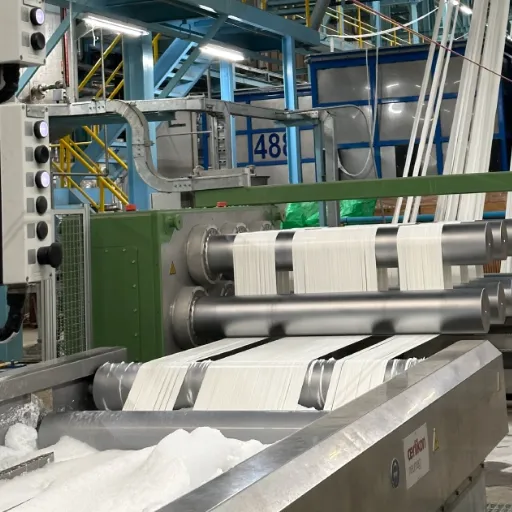
Fashion and Textile Industry
Polyester fabric has crucial implications in fashion and textiles due to its versatility, durability, and economy. It shrugs off shrinking and stretching, therefore it retains its level shape for the obviously needed longevity and resilience of apparel. This synthetic material is further blended with natural fibers for added softness, breathability, and utility.
One of its greatest advantages, from a care-conscious point of view, is its being an easy-to-handle fabric. Light-weighted, it resists wrinkles and dries quite fast and is much appreciated by the manufacturers and buyers alike, seeking low maintenance garments. Given this, polyester finds applications aplenty in casual wear, sportswear, and outerwear, which are ideal for use in various terrains.
The laying-edge feature of the fabric, however, is the retention of colors through dyeing, thus the acceptability of this material in fashion. It is a dyed canvas that plays metamorphic roles from everyday wear to vigorous resistant sportswear. With its low price, polyester has cemented its place as the staple fabric of the fashion industry, catering to needs both for mass consumption and for the special-order market.
Industrial Uses of Polyester
Polyester is an industrial chemical, given its ever-present application in the field of buildings or interiors, because of its durability, versatility, and cheapest cost. One of the primary uses of polyester is textiles for upholstery, drapes, and other interior furnishings. It shrinks or stretches or even creases, therefore is especially used for upholstery where long-standing solutions for homes or offices are required.
The other applications of polyester include the manufacturing of industrial fabrics such as conveyor belts, filter fabrics, and tire reinforcements. Because polyester can take on heavy stress and is lightweight, it is one of the preferred materials for such tough applications. Alongside these qualities, it also includes chemical resistance and abrasion resistance that guarantee its reliability and durability in even harsh conditions.
Making polyester is needed when they make high-performance plastic goods such as PET (polyethylene terephthalate) bottles and food packaging. The strength, clarity, and recyclability of polyester are considered in these applications, and they define its role in environmental damage reduction.
Home Goods and Performance Fabrics
Polyester has gained much acceptance in the production of home goods and performance fabrics due to its usual versatility and other properties. It is resisted against wrinkles, stretching, and shrinkage, so it gets used in bed sheets, curtains, and upholstery. In this manner, the fabric fits into the day-to-day needs of a household. Moreover, polyester protects its colors from fading, thereby assuring the good looks of items for a long time, well after endless washes and heavy use.
Polyester also is a unique force when it comes to the performance fabric trade. Used in active wear and outdoor gear, polyester is a moisture-wicking fabric-that sustains the moisture level of being dry and comfortable for its wearer under any conditional phenomenon. The sturdy resin resists such harsh-abrasion force to support its own use. So along with abrasion resistance, it being quick-drying offers another angle of convenience for the active-wearers, the wet-environment-forced professionals.
Flexibility is yet another character of polyester when told by its blended fabrics. When blended polyester fabric with cotton or other natural fiber, manufacturers get textiles that offer greater softness, breathability, and textile performance. That makes the search for a high-performance and long-lasting fabric in both home and apparel an item of great chase for comfort and practical.
Environmental Considerations of Polyester
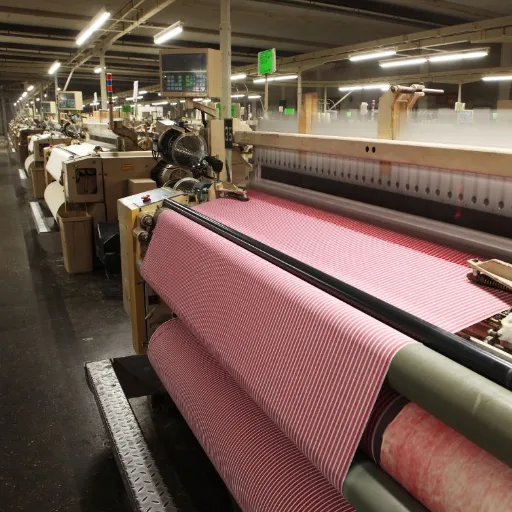
Sustainability and Recyclability of Polyester
Polyester is accused of polluting nature, whereas it holds some potential for the sustenance of the environment when handled responsibly. An important traditional advantage of polyester is its recyclability. The polyester fabric can be recycled into new polyester fibers and reduce the consumption of virgin materials to the factors for resource conservation. Under good circumstances, this reduces the amount of plastic in landfills and is, therefore, a good choice.
With technological advancements came the improvement of recycling processes for polyester. Mechanical recycling melts polymers to form new fibers, whereas chemical recycling reverses the polyester back to its original ingredients, thus making it possible to produce fiber of the same quality as that produced from virgin polyester. Both ways can, therefore, greatly reduce energy consumption and greenhouse gas emissions when compared with polyester production from raw materials.
Yet another bottleneck to globalizing polyester recycling activities remains in complex chemicals. It is often dependent on situations where separation of polyester of blended fabrics occurs and this is considered time-consuming and expensive. At the same time, not every plastic product is designed for recycling by itself. Therefore, next to an improvement in fabric design, waste management has still to face the challenge of innovation. Both consumers and manufacturers can be part of the solution by supporting polyester recycling infrastructure and buying recycled polyester.
Challenges: Fossil Fuel Dependence and Microfiber Pollution
Environmental Challenge: Polyester is a synthetic polymer that is formulated primarily from petroleum, a non-renewable fossil fuel. The first step in polyester production from petrochemicals would be crude oil extraction and refining to produce raw material precursors like ethylene. The ethylene so obtained is then subjected to chemical treatment with other compounds such as dimethyl terephthalate or purified terephthalic acid to make polyethylene terephthalate or PET-the most widely used polyester. The process of making the polyester eventually leads through polymerization, wherein bonding of molecules into long chains occurs to produce a strong and durable material.
Once the polymer of PET has been prepared, it is melted and pushed out through spinnerets as very long and exceedingly thin fibers. The fibers are then cooled, stretched, and otherwise treated to improve their strength and elasticity. Next, these fibers are spun into yarns or woven into fabrics according to the intended use. Polyester is highly versatile as it can be manufactured in several forms: filament, staple fiber, or film, and find applications in a variety of textile, packaging, and industrial uses.
The polyester production process is energy-intensive terms and on fossil fuel, bearing major effects on the environment. Innovations, like the recycling of PET plastics and use of bio-based alternatives, are now being developed to create a reduced environmental impact in polyester manufacturing. Since this awareness is spreading across the world, both the textile and fashion worlds are trying to tap into sustainable measures to check this problem.
Innovations for Eco-Friendly Polyester Production
🌱 Sustainable Innovation Highlights
The production of an eco-friendly polyester is being revolutionized by recycling technologies, bio-based materials, and energy-efficient processes. One such innovation is new-age recycling of PET plastics and fibers, where the used materials are depolymerized and then repolymerized into good-quality polyester. Mechanical and chemical recycling are two prominent methods, with chemical recycling restoring polyester to its virgin quality from a durability and performance standpoint.
Another perk is the application of bio-based alternatives to traditional polyester. They are produced from renewable sources like plant-based feedstocks instead of petroleum, which greatly reduces the dependence on fossil fuels. Bio-based polyester has properties akin to traditional polyester and is in line with the global agenda of reducing carbon emissions and moving towards sustainable manufacturing processes.
Simultaneously, efforts are underway to make the production process energy-efficient. Since the fabrication of polyester consumes just too much energy, low-temperature dyeing techniques and integrating renewable energy sources at the factory level will be innovations that can reduce energy consumption and the environmental impact of polyester synthesis. The adoption of these technologies represents huge steps by the industry to secure a sustainable pathway of polyester production, which is one of the most pressing environmental issues faced by textiles.
Frequently Asked Questions (FAQ)
Q: How is polyester made from recycled materials?
A: Polyester is made from recycled materials by breaking down plastic products, which include water bottles, to their basic chemical components in a process. After this, the recycled plastic is cleaned and converted into polyester fibers. This helps in reducing the waste and promotes the making of eco-friendly polyester fabrics.
Q: What is the primary material used in the manufacture of polyester?
A: Petroleum-derived substances make up the primary raw material for the production of polyester. Polyester polymers are prepared mainly using two chemicals: ethylene glycol and terephthalic acid. These substances are chemically reacted to produce polymer chains known as polyester, which are then cut short or lengthened into fibers.
Q: Can polyester be made from plant-based sources?
A: Yes, polyester can also be made from plant-based sources. Producers of plant-based polyester use ethylene derived from renewable sources to develop biodegradable polyester fibers. Producing this kind of polyester is becoming increasingly popular because it offers the toughness of synthetic fabric with environmental sustainability.
Q: How many forms can polyester take once it enters the textile industry?
A: Polyester enters the textile industry in several forms, such as polyester staples, polyester tow, and molten polyester polymers. These are then either spun into polyester threads or woven into various types of polyester fabrics for clothing and other purposes.
Q: Compared to other fabric types, how costly is polyester?
A: One of the few benefits that polyester has over other fabrics, such as cotton and nylon, is the price difference. Being a synthetic fabric, polyester is cheaper to produce, thus serving the interest of all manufacturers and buyers.
Q: What are the general uses of polyester in garments?
A: Polyester is widely used for clothing due to its versatility and durability. It is frequently present in garments such as shirts, jackets, and sportswear. Because polyester fabrics can wick water, resist wrinkles, and eventually fade, they are excellent for sportswear and even casual wear.
Q: Are polyester fibers biodegradable?
A: Normal polyester fibers do not biodegrade, but with the help of some new technology developments, it has been possible to develop some biodegradable polyester, which under certain conditions, will break down, thereby giving a better alternative from an ecological point of view to the classical polyester fabric.
Q: How are the polyester fibers produced?
A: Polyester fibers form during production when molten polyester is extruded through spinnerets having very tiny holes. The molten polyester is cooled and solidifies into long strands that are cut into staple lengths or left as continuous filament yarns for use in different textile applications.
Q: What are the effects of polyester manufacturing on the environment?
A: Polyester manufacturing and theirs extensive utilization raise environmental concerns mostly because of its petroleum-based origin. Nevertheless, areas of recycling and plant-based polyester try to alleviate some of these problems by reducing the use of fossil fuels and cutting down on waste.
References
- Sewport – Polyester Fabric: Properties and How It’s Made: This source explains the synthetic and plant-based polyester production process, including its derivation from petroleum.
- Maker’s Row – What Is Polyester Fabric: How It’s Made & Where: This article details the polymerization process used to create polyester from oil product waste.
- Made How – How Polyester is Made: This resource provides an in-depth look at the materials and manufacturing process of polyester, including its origins from coal, air, water, and petroleum.








